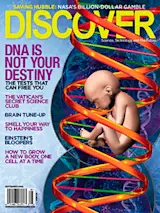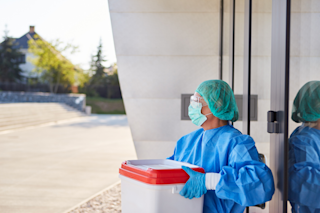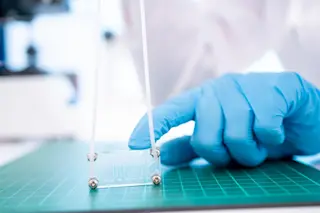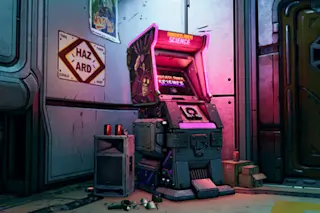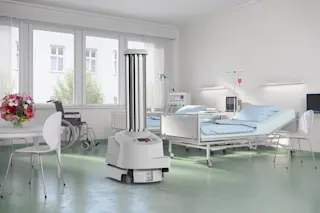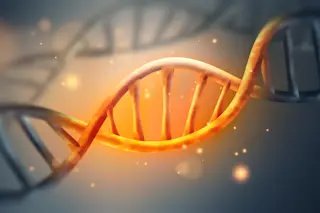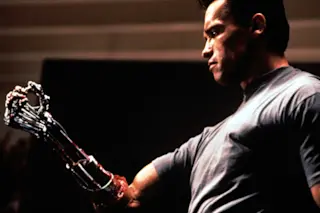Whether defying the dean of the University of Pennsylvania School of Medicine so he could publish a book on world health or challenging the titans of cosmology, Robert Lanza has never followed the script. It’s no wonder, then, that this renegade doctor would lead the charge into medicine’s most controversial turf: the creation of cloned embryos for therapy and the engineering of spare human parts.
The value of therapeutic cloning has long been clear to Lanza, who did his early work with South African heart transplant pioneer Christiaan Barnard. Starting from those early days, Lanza understood that the barrier to tissue transfer was rejection by the recipient. From an entire organ to a dose of embryonic stem cells, if the tissue’s DNA came from anyone else, the transplant would be rejected without the aid of harsh immunosuppressive drugs. “The treatment could be worse than the problem,” Lanza found. But embryonic clones, the source of an endless supply of stem cells imprinted with one’s personal DNA, could alter the equation in favor of the patient and augur a paradigm shift in medicine on par with the changes brought about by antibiotics and vaccines.
Lanza’s single-minded quest to usher in this new age has paid dividends in scientific insights and groundbreaking discoveries. Today a world force in the field of regenerative medicine, he’s close to delivering cellular therapies that might reseed the immune system, heal damaged hearts, even save limbs. Yet for almost 20 years government policy has kept his innovations literally on ice. He has been called a murderer for tampering with embryos, and personal threats were so common at one point that he believed he would be killed.
Enduring tough times and fighting for his beliefs suit Lanza well. He grew up poor in the Roxbury section of Boston and, later, suburban Stoughton, where he had a difficult relationship with his mother and was distanced from his professional gambler father. Year round, Lanza says, he was rarely allowed inside his own house except to eat dinner and sleep. With nowhere else to go, he spent his youth roaming the nearby wilderness immersed in nature’s mysteries.
Though initially labeled “slow” at school, in 1969 Lanza distinguished himself by transferring genes from black chickens to white ones when he was just 14, a mere three years after scientists cracked the genetic code. That extraordinary early feat, eventually published in Nature, signaled a raw scientific talent that his mentors (who came to include Jonas Salk and B. F. Skinner) likened to Einstein’s. In a 2001 article, U.S. News & World Report called Lanza the “living embodiment” of the fictional genius in the movie Good Will Hunting, whose Massachusetts accent is as thick as Lanza’s own.
Today Lanza lives on an island in a small Massachusetts lake, keeping a veritable museum of fossils and dinosaur bones and surrounded by the nature he cherishes. DISCOVER senior editor Pamela Weintraub interviewed Lanza at his Worcester office.
You have always bucked authority, haven’t you? In the real world, people had a different plan for me, the boy from Roxbury with a family so rough and lacking in education. There would be fights. The police would be called.
The Stoughton public school system had three classes in elementary school: A, B, and C. I was put in the C class with the kids throwing spitballs at the teachers, the ones who had been held back.
How did you cope? There was a golf course nearby, so I earned money by collecting and returning golf balls. When I had saved $18.95, I had enough to mail-order a little squirrel monkey, sitting in the palm of a woman’s hand, that was advertised in the back of Field & Stream. I sent in my money and forgot about it, but a year later I came home from school and there’s this monkey in the middle of the kitchen, tied up inside a box with these pellets in it. “Stay away; it will attack,” my mother said, but here was this little teeny baby squirrel monkey. It was sneezing; it had a cold. I went up to it and it just curled up. And it became my best friend. It was just like a little person—little fingerprints, everything. It was actually smarter than a lot of my friends.
Back then I was on my own. I went into ponds to get snapping turtles. I would go out for miles in the middle of the winter, using footprints to track raccoons. I fell through the ice on a pond 15 miles from civilization up to my waist when it was below zero. I would go up in trees and catch little screech owls in their holes. I’d go on long excursions trying to figure out how the universe worked. Even at that early age, I was in awe and wonder of the world.
A squirrel monkey and nature sustained you. Was that enough? Fortunately, I also had a neighbor, Barbara O’Donnell, and her husband, Eugene—wonderful people. If I brought a bug to them, they’d buy me a magnifying glass; if I found a bird egg, they’d get me a book on birds. Every now and then you run into an extraordinary human being who does things selflessly, and Barbara O’Donnell was like that. When a black family moved in next door, the neighborhood tried to stop it, but Barbara interceded. She always fought for what was right. They say that you incorporate the superego structure of your parents. Well, not my parents, but hopefully I’ve incorporated Barbara’s and Gene’s. Today my colleagues and the [Catholic] Church and the president and even the pope can attack me and it’s just like, you know what? I’ve seen a lot worse. Say what you want. I’m doing what I think is right.
It’s lucky that you were able to find such kindness and support. Yet school officials still kept you in the C class? When I was in the fifth grade, my teacher realized that I didn’t fit in the C class and encouraged me to do a science project, so naturally I did it on animals, and my best friend, Steven, did his on rocks. He won first prize and I won second. That was my first entry. That’s when I began to feel I shouldn’t have been pegged because of my family circumstance, and that people should be able to prove themselves.
I take it that’s what you did to prove yourself. Every year after that I did a science project, and in the eighth grade, Barbara O’Donnell, my neighbor, became my science teacher. If not for what she did for me then, I wouldn’t be here today. She arranged for me to be in the honors biology class in high school, something that was actually open only to the students at the top of the A division. It caused chaos because I leaped over all these people ahead of me. “In this one honors class, biology, they’ve got this loser....What is this the rats dragged in?” I was determined to prove them wrong. So I hatched an idea to win the whole science fair, something that only seniors had done. My plan was to alter the genetic makeup of a white animal and make it pigmented.
The genetic code had been cracked only three years earlier, in 1966. Still you planned what amounts to genetic engineering. My honors biology teacher told me it was impossible. That made it a challenge. I saved up nickels and dimes from the golf balls and took a bus and trolley to Harvard’s Countway Library of Medicine. I ended up finding an article on extracting nuclear protein [containing DNA] from cells using ethanol. Barbara drove me to a farm to get eggs laid by pigmented chickens and we tracked down another farm to get eggs from white Plymouth Rock chickens. I still remember trying to get the equipment. I went to the hospital and talked them into giving me syringes. Another hospital gave me penicillin so my animals wouldn’t get infected, and I found a guy who worked at one of the state labs who had a centrifuge and chemicals in his basement—that’s where I extracted the DNA. But most of the work I did at home. My mother would not allow me to have anything in the house, so I found an unfinished back room next to the furnace in the basement, and there, in a little corner, I built an incubator for the white chicken eggs. At a very early stage, I introduced the pigmented genes into the white embryos with a syringe. Which, of course, was very problematic because I had to figure out how to make the eggs so you could see where the right spot was, and most of ’em you would kill or they would die. There I was trying to alter the genetic makeup of a chicken, and my mother’s talking to a neighbor saying, “Oh, yeah, Robby is trying to hatch chicken eggs.”

NULL | Michael Lewis
Did it work? Some of the white chickens were born with patches of pigmentation. But to truly prove it, I had to make my experiments blinded and controlled. What I needed was to do these experiments more correctly, not in my basement, and now I’m thinking, “OK, I really need to talk to someone who understands this stuff. So I’m gonna go to the greatest place on the planet, Harvard Medical School, and I’m gonna talk to a Harvard doctor. Now it’s time to take this up a notch. We’re gonna get serious.”
Did you make an appointment? Oh, no. I didn’t even know where I was going. I’m walking around asking people how to find Harvard Medical School. I had no clue. I finally find it, with all that granite and slab stairs worn from the generations of people coming and going. My endorphins are flying. I go to the front door and the guard would not let me through. I’m not giving up that easy. I went all around the building trying all the doors, but everything’s locked. So I stood by some Dumpsters trying to look inconspicuous until someone came by—this little short guy, bald, with khaki pants and a bunch of keys in his hands. I figured it was the janitor. So he opens the door and I just sort of slip in. He keeps walking, but about halfway down the corridor he turns around and says, “Can I help you, sir?”
“No. I’m looking for a Harvard doctor,” I said.
Now, what I didn’t know was that this was Steven Kuffler, chair of neurobiology. Instead I told him that I was friends with a janitor who lived down the street from my house and that I worked at the school cafeteria washing plates. I’m from the underprivileged class too, I said. He knew I thought he was the janitor. He said, “Why are you here?” I said, “Oh, it’s got to do with nuclear protein and inducing melanin synthesis in albino chickens.” I could see that I was impressing him. He has no idea what DNA is, [I am thinking]. Finally he said, “Well, I think I know someone who can help you.” I remember him bringing me up in the elevator, past all the spaghetti wire, all that neurobiology equipment and circuits—it was so awesome and impressive—right to Josh Sanes, who now runs the brain center at Harvard. He was just a grad student at the time, putting probes in caterpillars and looking at their neurons. I talked to Josh all day. Eventually they invited me back to repeat the experiments correctly. The paper was ultimately published in Nature in 1974. Every now and then the janitor would show up and I was so excited to see him. It was only later that I found out who he was.
So what happened back at the high school? The teacher gave me a C and everyone else got an A. He didn’t like the way I wrote it, but the grade was changed after I won the state science fair. The night of the science fair, my mother tried to stop me from leaving. “You’re not going anywhere,” she said. Barbara was out front honking the horn, waiting to give me a ride. I said, “Ma, I’m going. I don’t care what you say.” This was the first time I rebelled like that. I remember her breaking down in tears. When I arrived, the whole gymnasium was overflowing out the back door. Then they went from the bottom up, fourth grand award, third grand award. And then I was first grand award, and I noticed my mother was in there—she did show up at the end. Then I got the Massachusetts Medical Society Award, and The Boston Globe gave me an award. That was my vindication that I wasn’t stupid.
You got to the Ivy League, and soon you were working with heart transplant surgeon Christiaan Barnard. How did that happen? At the University of Pennsylvania, I was in the University Scholars Program. We could take any classes we liked as undergraduates, so I started taking medical school classes in 1975. It was a wildly exciting time for heart transplant medicine, so I wanted to go to South Africa to work with Christiaan Barnard. I wrote to Barnard, and he said, “Yeah, you can come.” It was fascinating but horrific. Some of the heart transplant patients had run out of their immunosuppressive drugs; they couldn’t breathe. They were in wheelchairs. Their bodies were rejecting the organs and they were dying with their families all around them. Anyway, I came back to Philadelphia with a whole pile of papers coauthored with Barnard.
Obviously you didn’t go into surgery. What came next? By the time I graduated from medical school, heart transplant surgery had become conventional, so I moved to Los Angeles and did something I’ve never told anyone else about: I spent a couple of years rolling pennies and eating canned spinach and pasta while I tried to understand the universe, an effort I felt had reached a dead end.
Dropping everything to spend years thinking about cosmology could be called self-indulgent. For me it was the equivalent of hiking around Europe—I was hiking through the universe, and I needed the intellectual freedom to just think. I’ll tell you, putting the puzzle together is not trivial, but after two years I had a new theory of the universe.
Your book on that work, called Biocentrism, cowritten with the astronomer Bob Berman, will be out soon. In it you propose that our current theories of the universe will never work unless they account for life and consciousness. Can you explain?
Look at this coffee cup. You say it’s right there, but the truth of the matter is you can’t see that through your brain. Your brain has a bone around it. What is happening is that what you see is reconstructed in your mind. We have these words space and time, but you can’t touch them. They’re not objects, they’re not things, they go forever. Space and time are really tools of animal sense perception, the way we organize and construct information.
You have suggested that reality is determined by the conscious observer. Most physicists view consciousness as an accident. There was a paper published in Science this February, and what it showed was that if you do an experiment with a photon, put it in the apparatus, that what you do right now actually changes an event that already occurred in the past. Now isn’t that bizarre? That is the same universe that you and I are in. How can the physics in this experiment actually show that if you do something right now it retroactively changes an event that has already happened? You can play your little games with it, but any way you cut the pie, if you observe something it acts as a particle, and if you don’t it acts as a wave. It is not an artifact of the system. Those experiments are real. Get over it.
You’ve said physical laws are exactly balanced for life to exist. If there were one-billionth of a difference in the mass of the Big Bang, you couldn’t have galaxies. If the gravitational constant were ever-so-slightly different, you couldn’t have stars, including the sun, and you would just have hydrogen. There are 200 parameters like this. We now have people out there talking about an intelligent design, saying “God” is the explanation. But it is really because quantum theory is right: Everything is observer-determined and the past and present are relative only to you, as the observer. It all fits, but the problem is, you then do need to accept what people will not accept: When you turn your back to the moon, it no longer exists.
Despite the cosmic uncertainty, you went on to pursue a most tangible goal. Considering my small role in the universe, I thought I could best apply myself to trying to treat or even cure diabetes, and possibly other diseases that affect the health and lives of millions. Instead of transplanting whole organs like the heart, I decided to work with cells—from a biocentric viewpoint, the fundamental units of reality and the bedrock of our observer-determined world. The person I approached was Patrick Soon-Shiong, a UCLA professor who was trying to transplant the insulin-producing cells called islets as a treatment for diabetes. The hurdles there were similar to those we faced with heart transplants: overcoming a shortage of tissue and preventing rejection.
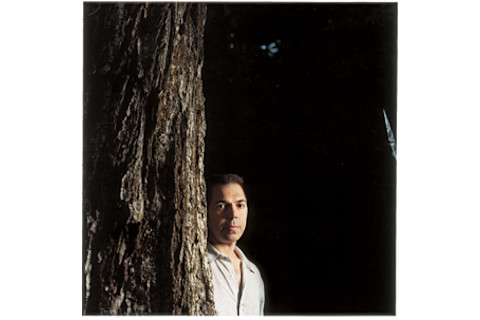
NULL | Michael Lewis
What was the strategy? At first I thought we could isolate islets from cadavers or animals and protect them from rejection by putting them in little capsules. We managed to get around that with our first patient, a Boeing executive with pancreatitis. He had to have his pancreas removed, and instead of throwing his gland away, we took it back to the lab and got maybe 50,000 to 100,000 of these insulin-producing cells. We injected the cells back into his portal vein and they took up home in the liver and the guy was fine. It made a lasting impression on me because what it meant was that if you could deliver a person’s own cells, you would eliminate the risk of rejection, and you could give the patient insulin-producing cells without the need for insulin injections for the rest of his life.
How did you get from islet cells to embryonic ones? Around 1990, when I was still at UCLA, I was approached by BioHybrid Technologies in Shrewsbury, Massachusetts. At first I thought, “Why would I leave sunny California to go back to the rain and slush and snow?” But I went out for the interview and the president, a brilliant man named Bill Chick, asked me what would make me happy. I threw out what I thought was a preposterous figure for a salary, and when I got home there was a message saying it had been accepted. I didn’t realize at the time that it was below the market rate. At the company Christmas party I met his daughter, and she said, “So you’re the one with the tacky tie. You’re the one my father stole.”
It turned out that Chick had suffered from diabetes since childhood. Now he was dying, but he wanted to save himself by using the encapsulation method I had proposed at UCLA. It was a race against the clock—Bill had so much angioplasty and heart surgery he was being glued together. After a while we actually succeeded in dogs. We got islet cells from the pancreases of healthy dogs, encapsulated them, and transferred them to diabetic dogs, who became insulin independent. That’s when I learned about Dolly, the sheep cloned by the Roslin Institute in Edinburgh, Scotland, and I said, “Aha! That’s it.” If you can create an embryo genetically identical to the adult—that is, a clone—you can harvest immune-compatible cells to replace any tissue you might want without fear of rejection.
In essence the clone would supply stem cells to the parent? Right. You can do all kinds of tricks with embryonic stem cells, but if they come from another individual, you still have the problem of rejection. You still need powerful immunosuppressive drugs that cause cancer. My idea was to clone the sick individual, not for reproduction but for therapy. The stem cells produced through this therapeutic cloning would, like other embryonic stem cells, be capable of developing into many cell types and serve as a repair system for whatever part of the body required replenishment at the time. You solve the rejection problem, and you have unlimited amounts of tissue. I tried to convince Bill to try this, but he wouldn’t budge. In the end he had strokes and didn’t know what was going on. He died in 1998 in front of my eyes.
Then I learned there was a cloning company right up the street from BioHybrid that was the top in the world, called Advanced Cell Technologies, or ACT. It was almost like fate. By then I was attached to Massachusetts. I’d bought a little island, where I lived. I had all my fossils and dinosaur bones there, and I had landscaped it. My island had swans; it had a beaver and a beaver den 10 yards from my door. I wanted to stay around.
So you went to ACT and asked for a job? Before they would hire me, they gave me a task that was like bringing back the witch’s broom. There was a question about whether the National Institutes of Health would allow the work. Even though this was for therapy and not reproduction, it still involved cloning embryos, and the public was totally against it. Many considered it murder. So I was asked to get all the Nobel laureates in the country to sign a letter to support embryonic stem cell research, addressed to Harold Varmus, the head of the NIH. This was in the old days, when everything was by fax. Actually, I had this whole drawer of all the letters signed by 70 Nobel laureates. The effort was published in Science, and a few months later, many college presidents also signed on.
At the time, ACT was a subsidiary of a poultry genetics company, doing work in agriculture. When I joined they made the move from animal cloning to human therapy, and we knew we would get hit, big-time. I may be the only person who’s had the [Catholic] Church, the pope, and a couple of presidents condemn my work. At one point we had bodyguards here. There was a bombing up the street; then a doctor at a local in vitro fertilization clinic was targeted. I didn’t think I would be alive for more than a few years.
And you, alone on your island, were so vulnerable to attacks. I would go for a walk, listening for sounds. I was one of the most visible people in cloning and yet I was isolated. I figured there was more than a 50 percent chance that I would be knocked off. But I wanted to go out trying. I’ve always followed my heart.
Can you describe the original groundbreaking work at ACT? We injected human DNA from an adult cell into an egg from which the nucleus had been removed. We managed to clone early-stage embryos that grew to four or six cells in size. This was obviously far short of getting stem cells, which require a blastocyst [an embryo with a larger cluster of cells]. In fact, even to this day, a decade after the cloning of Dolly, scientists still have not cloned human embryos developed enough to generate patient-specific cells.
You’ve been exploring other ways of producing patient-specific cells. What are they? We recently published a paper on a cell we created called a hemangioblast, which exists only transiently in the embryo but not in the adult. I think of them like unicorns, these elusive cells that we had hypothesized and sought for years. With the ability to become all of the blood cells—including your immune cells, red blood cells, all of your blood system, as well as vasculature—hemangioblasts have been biology’s holy grail. What we discovered is that we can create literally millions or billions of these from human embryonic stem cells. Now that we have them, we are harnessing, for the first time, one of nature’s early, most profoundly powerful cellular building blocks. The point is, we can use transient, intermediate cells like hemangioblasts as a toolbox to fix the adult so you don’t have to have limbs amputated, so you may not have to go blind, to prevent heart attacks. We can direct their development into different cell types by adding certain molecules to them as they divide.
How does it work? We found that when we injected these cells into a damaged, ischemic limb, there was almost 100 percent restoration of blood flow in a month. Before, the limb would have been amputated, but now it was restored. As to heart attack, injection of the cells cut the death rate in half.
Since these cells give rise to the immune system, what about using them to treat autoimmune diseases? There are more than 80 autoimmune diseases. What’s interesting is that when you do a bone marrow transplant for cancer, some of those with autoimmune disease go into remission, as if the immune system has been eliminated and allowed to rebuild from scratch. Using hemangioblasts that are the progenitors of the immune system, we’re hoping we can replace the immune cells too.
Are there other, intermediate embryonic cells that might, in similar fashion, give rise to the nervous system or brain? Yes. The way to think of this is that you have a tree with branches that give rise to all of the different tissue types of the body. The hemangioblast, for instance, gives rise to one branch—to blood cells, vessels, and the immune system. But there are also neural stem cells as well as early progenitors that have this plasticity in most of the other systems of the body. Right now we’re trying to discover how to isolate and expand them.
You’re a bit limited using just cells. You started out with Christiaan Barnard transplanting hearts. To realize the full potential of stem cells, we must learn to reconstitute them into more complex tissues and structures. So if we want to make an artery or bones or even an entire kidney or a heart, we need to learn to assemble and grow them on a biodegradable scaffold, which the body can later absorb. In one study we used the cells to make little kidneys that even produced urine. The urine had concentrated creatine or urea, meaning the kidneys were actually removing toxic materials from the blood. Entire bladders have been grown this way. Other researchers are doing bones, heart valves, and cartilage for joints.
This seems like lifesaving technology on an unprecedented scale, yet the work has been stymied by politics. It must be frustrating to have these cells sitting around the lab, in storage, when you could be helping people. Four years ago I was driving to work, going up a hill on a quiet little road with a speed limit of 15 miles an hour. I was in a rush and whirled into the parking lot, and there’s this police cruiser next to me. I almost hit it. “Oh, jeez, now I’m screwed,” I thought. I went into my office, started working, and a few minutes later a scientist from the next office over comes in and says, “Bob, there’s a police officer out there who wants to see you. He has handcuffs and a gun.” The whole lab is thinking he’s there to arrest me. He says, “Dr. Lanza, could I speak to you in your office?” so I brought him in. It turns out that I had just published a paper showing that we could create human retinal pigment epithelial cells capable of restoring visual function in animals. The officer had a 16-year-old son who would go totally blind in two years without the therapy. By the time he finished his story, I was almost in tears because we had these cells and they had been frozen at that point for nine months.
Why couldn’t you take them out of storage to help the boy? We didn’t have $20,000, which is what we needed to do the preclinical studies required for working with people. At that point, our phones had been turned off. We didn’t have a fax machine. I couldn’t even afford bottled water for my pipettes. The point is, there is just no funding because basic research is generally funded by the government and the government will not fund stem cell work.
What else are you storing, still unfunded, in the vault?
We have cells that reverse paralysis in sheep that have spina bifida and can’t walk. After we injected our cells, the first animal that we treated returned to normal and was walking fine. The same model could work for paralyzed humans, but without funding, we haven’t been able to repeat the experiment in five years. People are in wheelchairs when there could be a cure.
A few years ago a woman contacted me. In the course of chemotherapy for a tumor, something must have been activated, and for some unknown reason the glial cells in her cerebellum had started to degenerate. She was a lady with all these kids. Slowly she started to lose her ability to talk. She began to use a walker. She got worse and worse, and then, not long ago, she died.
You could have helped her? Yes, we have cells that probably could have helped her with a single injection. One of her sons kept coming and asking, “Is there anything you can do?” But we didn’t have the resources to go through the process at the FDA. It’s heart wrenching to see this happening, knowing that this work is being held up.
Amid all this, are you still trying to achieve your first dream, harvesting embryonic stem cells from human clones? We’re continuing this work, but with less urgency since the discovery of induced pluripotent stem cells, or iPS cells—adult cells that have been reprogrammed back to an embryonic state. We’re working on new ways to reprogram skin cells that would allow us to safely create a bank of stem cell lines that would closely match the population as a whole. It turns out that only 100 cell lines could give you a complete haplotype, or immune, match for 50 percent of the U.S. population. These reprogrammed cells are not as controversial since you don’t use cloning or embryos.
What do these technologies portend for human longevity? It turns out that the human life span plateaus as it approaches a roof of about 120. By eliminating infectious diseases, some chronic diseases, and cancer, we can get the life span past 100. I think with tissue engineering we can patch you together like a bicycle tire, replacing a kidney with a kidney and a heart with a heart, to about 120 years. That was always my thinking: That was the limit. But with these hemangioblasts, I now have questioned my own rules. These cells can go in and fix the damaged tissue inside, almost like nanoparticles. We may be able to do the same thing with similar cell lines for neurons, where we can repair the damage in the brain itself. So if it continues the way it’s going, we may break that ceiling, like breaking the sound barrier. I’d be very hesitant to put a lid as to where longevity is going to go.
You’re launching the future of medicine, but it is still on hold. Rather than curing disease, we’re trying to get around theological problems. It’s not what I signed up for in medical school. I can’t tell you how many times I’ve thrown my hands up and said, “Enough, I can’t take it anymore,” but then I’m back the next day. We’re crippled, but they can’t stop us forever. We’ve now got enough irons in the fire and hopefully ways to bypass many of these objections. But it’s just a shame that the research has been held up so long. We’re living through a paradigm shift. People are going to look back at us and say, “They used to cut people’s legs off.” Then they’ll just give an injection and the blood flow will be restored and the limb saved. If I were a patient and I knew I was going to have my leg cut off and something could be done, I would be demanding it. But most people, even most scientists, don’t realize what we’re capable of. I realize it because I’m doing the work and I can see what’s possible before my eyes.



